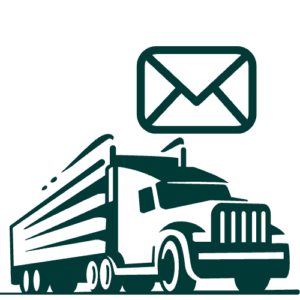Top 16 Trucking Company Performance Metrics You Need To Track
From routes to rates to rigs, trucking company owners are faced with a lot of decisions. To make the right call, you need data—an accurate picture of how your business is operating in real time. That data comes from key performance indicators, or KPIs, which are highly specific, quantifiable measurements.
But which data points should you track? Trucking company performance metrics will differ based on the size of your operation. Large fleet carriers may analyze everything from load weight to routing; these factors help them shave delivery costs, achieving noticeable gains when scaled across hundreds of trucks. However, the small fleet owner or owner-operator probably won’t benefit from this level of granularity. If you operate between one and five trucks, focus on trucking KPIs that affect your bottom line and inform your operational choices directly. These metrics will help you manage your budget, boost revenues, and improve operational efficiency as you grow your fleet. In fact, without them, it’s hard to grow at all.
Trucking Company Performance Metrics For Small Carriers
Organization is a key challenge for data-driven decision making. Manage your data by separating KPIs into distinct categories, as we do here. While these trucking metrics interact with one another—and mixing and matching the data can help you make better choices on everything from bids to equipment purchases—it’s best to start with separate spreadsheets for each of these areas. Look to your accounting software for financial data, telematics dashboards and electronic logging devices (ELDs) to track truck performance, and driver reporting for load management figures.
Financial Metrics
The following KPIs can help you set a budget that matches your real-world cost of operations. These are bottom-line KPIs: data related to money coming in and going out.
- Topline Revenue. It is essential to track money coming into your business. This metric tracks sales to determine whether you’re meeting your goals—and helps you create next year’s budget.
- Fuel And Diesel Exhaust Fluid (DEF) Costs. How much are you spending per gallon of fuel? In your budget, you’ll have to project an average cost per gallon for fuel—though, of course, actual prices will vary over time. It’s also helpful to track the cost of DEF per gallon separately or combined together with fuel costs.
- Average Miles Per Gallon (MPG). To project operating costs, you need to know the average MPGs your fleet achieves. When you know what kind of MPGs your trucks get, and the cost of fuel/DEF, you can estimate the total cost of hauling a load a certain distance. That will help determine your bid and plan your budget more effectively.
- Truck Downtime. Watch for patterns in maintenance downtime, especially if you run older vehicles. Longer periods of downtime may require you to rent a substitute unit or avoid bidding on certain jobs. Tracking this metric alerts you to these decisions and may require adjustments to your yearly revenue goals.
- Preventative Maintenance (PM). Carriers set different PM schedules based on mileage or date interval depending on the type of maintenance required. Additionally, your truck and trailers require a DOT annual inspection. The important thing is to plan for these predicted interruptions to truck service—and ensure that all PM is completed on schedule. You’ll also want to track what you spend on maintenance.
- Tolls. If your routes include toll roads, track those costs. You may have to pick between avoiding tolls and on-time delivery, and knowing how this expense plays into your overall operation will help make that an easier choice.
- Other Fixed Costs. Your truck and insurance costs will remain the same whether you are moving or not. You may pay your drivers a salary; those labor expenses are another important financial metric. Drivers that are paid by the mile would be classified as a variable cost. Keep track of these core expenses.
- Other Variable Costs. Fuel and DEF aren’t the only costs that change over time. You may need to pay for truck wash, fluids, or tools and supplies. Track these figures as well. You’ll need this data to figure out the most important trucking company performance metric of them all: cost per mile.
- Cost Per Mile (CPM). This KPI measures your cost to haul a load a single mile. It’s best to monitor your CPM frequently, at least every month. Find your CPM by adding up all the overhead and operating costs associated with keeping your trucks on the road, then divide by the number of all miles (loaded and empty miles) you covered in the same time period. When you know your CPM, you can easily multiply it by the length of a haul to determine a break-even cost for a given job; multiply that cost by your target profit percentage to determine a bid.
Truck Performance Metrics
The industrial internet of things (IIOT) is making it possible to track truck performance on a moment-to-moment basis, a practice known as telematics. Install telematics systems in your trucks to collect this data, which can provide visibility into operational challenges like diminishing MPG ratings. Here are a few telematics ratings to watch closely.
- Speed. Anomalies in truck driving speed can indicate delays along a certain route, which will play into your scheduling and transit time goals. They may also help to explain a higher or lower MPG figure. When in doubt, talk to your drivers to find out what’s leading to these changes.
- Engine Idle Time. Trucks that aren’t outfitted with auxiliary power units (APUs) need to idle during breaks and rest periods. Evaluating engine idle time—and the fuel costs associated with it—can help make decisions about equipment, like whether or not to invest in APUs.
- Engine Runtime. This metric records the time a truck’s engine spends running and can provide visibility into maintenance requirements, driver behavior, and overall patterns of use. Engine runtime can also reveal truck utilization percentages which, for carriers, are directly related to overall operational efficiency.
- Acceleration And Braking. Rapid acceleration and/or braking can indicate safety hazards on the road. As a driving style, they can also diminish fuel efficiency. Track these metrics for visibility into both scenarios.
Load Management Metrics
Load planning allows you to make sure your trucks are where they need to be, when they need to be there. Tracking the following KPIs can help you be a more reliable carrier.
- Transit Time. By projecting transit time goals for your routes, you can help to stay on schedule. When drivers fail to meet these goals, the telematics addressed above may have some clues as to why; maybe there’s construction on a certain route, in which case you may want to temporarily adjust your projected transit time, for instance.
- Shipper/Receiver Time. Some customers load or unload freight quickly; others won’t. By keeping track of loading and unloading times—and maintaining a running average for each client—you can improve trip planning to avoid missing appointments and improve your rate of on-time deliveries.
- On Time Delivery (OTD). This is a yes/no question, but tracking your OTDs can help with customer retention and expose potential operational problems. One way you can track OTD is to assign a value of 1 (for an OTD) or 0 (for a missed target) to create a percentage average over the year.
In addition to the above KPIs, carriers must also collect data on safety and compliance. Routinely evaluate your drivers’ hours of service (HOS) summaries. Maintain accurate CSA reports and updated driver qualification files for all your drivers as well.
Setting Benchmarks For Trucking KPIs
These trucking company performance metrics serve two crucial purposes: They allow you to create goals and determine whether you’re meeting them. But in order to set the goal, you have to establish benchmark ratings for each KPI. To find your baseline ratings for these metrics, start collecting data as soon as possible. A month may give you enough information to set a baseline for some metrics, but it’s best to collect information for up to six months to gain a clearer picture of performance.
Once you’ve chosen your KPIs and set benchmarks, monitor incoming data on a weekly, monthly, quarterly, and/or annual basis. Update your benchmark goals until they seem realistic, and make operational changes—new routes, new equipment, changing rates—if you’re not meeting your goals.
The main reason fleet owners track these KPIs is to create and manage a budget. However, even with careful planning, cash flow problems can arise—especially when shippers operate on net-60 terms, holding payments for up to two months. That doesn’t have to be a barrier to operation. The best solution is a contract-free factoring tool like Bobtail. This easy-to-use financial service app allows carriers of all sizes to access their payments quickly with same-day transfers. Unlike traditional factoring services, we don’t lock you into restrictive contracts, enforce volume requirements, or charge hidden fees. If your trucking KPIs suggest you need a payment sooner than your customers can deliver, Bobtail can help. Call us at 410-204-2084 to learn more, or click here to sign up and learn more today.
Article By
Keep Learning







